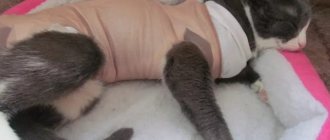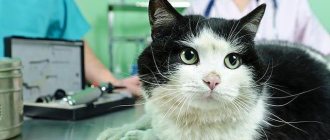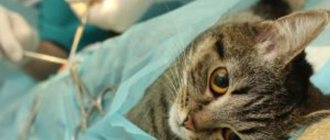Since ancient times, people have been surrounded by cats. They have the status of the most common pet. Pets relieve stress, give affection and warmth, amuse and make you smile. With their purring, emitted in a certain range, they treat their beloved owners. But it happens that cats themselves get sick. And then there may be a need for surgery.
Sterilization is also carried out through surgery. You can't do without anesthesia. What is the first thing an alarmed owner thinks about? Of course, about the risks, complications during anesthesia and surgery. Questions arise: how long does it take for a cat to recover from anesthesia, is it harmful to the animal?
What are the types of anesthesia?
They are as follows:
- Inhalation. A mask is placed on the animal's face, and the gas goes directly into the lungs. It is considered the safest for the animal. The drug is administered through the lungs and eliminated in the same way. The liver and kidneys are not stressed. If it is not possible to administer anesthesia through a mask, you have to insert an endotracheal tube into the cat's throat. If necessary, anesthesia is used. How long does it take for a cat to recover from anesthesia? He wakes up almost immediately.
- Parenteral. Anesthesia is injected into a vein through a pre-installed catheter. It is convenient because the dose of the drug can be accurately calculated and the amount of anesthesia administered to the cat can be controlled. Also, this method allows you to remove the animal from anesthesia smoothly, gradually reducing the dose. In this case, there is a load on the kidneys and liver, and it is these organs that will have to remove the remaining drug from the body. Technically easier to perform, because not all clinics have equipment that allows you to operate under inhalation anesthesia. The animal can sleep for several hours. In this case, both after a complex operation and after sterilization, the cat takes a long time to recover from anesthesia.
How cats recover from anesthesia after castration - features of the condition
The process of recovery from anesthesia is individual. Some pets behave aggressively, others wake up slowly and remain lethargic for a long time. An inexperienced pet owner runs the risk of being bitten or scratched.
The side effect of drugs is prolonged disorientation in space and impaired coordination of movements. To prevent the consequences of physical activity, the cat is placed in a place from which it cannot fall. The best option is to leave it in a carrier for a while, in a warm, dry place without drafts and away from heating radiators.
Be sure to read:
A sterilized cat asks for a cat: reasons, when it is the norm, what to do, how to avoid
What are the disadvantages of these types of anesthesia?
When using inhalation anesthesia, the animal's blood vessels dilate, becoming saturated with gas. There may be a risk of a sharp drop in blood pressure. You need the presence of a specialist who monitors all indicators. In addition, if an endotracheal tube rather than a mask is used, there is no possibility of direct access to the respiratory organs. Therefore, this anesthesia method is not suitable for lung operations.
Parenteral anesthesia is dangerous due to its unpredictable effect on the respiratory system. The cat is intubated. This means that during operations on the respiratory organs it is fraught with the occurrence of dangerous situations. In addition, the drugs put a strain on the liver and kidneys.
Both types of anesthesia individually are more suitable for minor operations. If there is a major surgical procedure, anesthesia will most likely be combined or mixed. The first involves using different substances in stages. In the second, more than two drugs are used at once.
What drugs are used for anesthesia?
There is a very common myth that anesthesia is harmful to animals. This is due to the fact that back in the nineties of the last century, operations on animals were carried out using heavy drugs, from which the pet might not wake up at all. The medications were from the list of narcotic substances. There was at least one accident per ten operations. Complications occurred frequently. Therefore, the attitude towards anesthesia is still wary.
Modern drugs that do not produce such severe consequences are now successfully used:
- Propofol, also known as diprivan and pofol. A lightweight drug that is more suitable for simple operations. The animal instantly falls asleep, sleep lasts about thirty minutes. How long does it take for a cat to recover from propofol anesthesia? Answer: after about an hour it is already quite adequate.
- Zoletil, he is also a domitor. Safe, induces deep sleep, no pain.
- Butorphanol. A drug for strong, long-term anesthesia.
Preparing your pet for surgery correctly
Before surgery, the veterinarian will examine the animal. Blood and urine tests will be required, and the cat will also be weighed and measured. You will need to indicate the pet’s age and the presence of any congenital diseases. You may have to visit the ultrasound room and have an ECHO of the heart.
Lighter and planned operations are scheduled for the morning. The cat's owner will have to reconsider his daily routine to ensure proper care for her after surgery. This is especially true on the first day. Everything will depend on how long it takes the cat to recover from anesthesia.
Before the operation, food is removed 12 hours, water is excluded 10 hours before anesthesia. This is necessary to prevent aspiration of vomit. In principle, the same requirements are presented to people before surgery. It is safer to perform surgery in a clinic. Take care in advance of transporting the animal home. If the cat cannot be taken to a veterinary hospital, veterinarians can come to your home. However, you cannot bring all the equipment, and sterility at home will not be at the proper level.
What will you need to prepare?
- Carrying is good before surgery. After this, you will not be able to place the animal there without harming it. A box will come in handy. The bottom should be covered with diapers, preferably absorbent ones.
- During the operation, the cat lies with its eyes open. Don’t worry, she doesn’t see or feel anything, it’s just how her body works. Special eye drops will come in handy to prevent the mucous membrane from drying out.
- If the season is cold, prepare a blanket. Wrap the box in it when you go home.
Be sure to ask your veterinarian how long it will take for your cat to recover from anesthesia in your particular case!
It is believed that after surgery it is advisable to leave the pet in the veterinary clinic overnight under the supervision of specialists. But if the doctors are sure that everything is in order and the animal feels more or less normal, after a few hours you can go home. The veterinarian will give recommendations for care.
How to behave when a cat recovers from anesthesia, what to do?
The first three days of the pet should not be lost sight of. You need to monitor the healing process and do not let the cat lick the wound. Otherwise, infection and purulent inflammation are possible. To prevent licking, wear an Elizabethan collar. The seams are treated with products recommended by the veterinarian. If the cat quickly came to his senses, the wounds do not bother him, and they should not be treated again.
Clean water should be nearby at all times. If the animal wants to drink, but cannot do it, you need to wet the mouth with a syringe or pipette, but do not inject it forcibly. You cannot feed your pet on the first day.
An empty tray without filler is placed next to the convalescent person so that the animal does not clog the wound. The toilet should be cleaned daily, or even better after each visit. If the first bowel movements do not occur in the tray, there is no need to punish. It may be painful for a cat to climb. When the condition returns to normal, the habit of going to the toilet will be restored.
If a cat is soiled with urine, it should not be bathed. You should use refreshing wipes.
What you should be prepared for
After surgery, a blanket is placed on the cat. It serves as protection against infections and prevents the animal from reaching the stitches. The blanket restricts movement; the cat is already weakened by the operation. Therefore, do not allow your pet to be on high objects - chairs, sofas, and so on. If the cat tries to jump, it may hit the floor and damage the seams. Place a basket or box on the floor and let it sit there.
The animal may be aggressive. Mood swings are common, no matter how long it takes a cat to recover from anesthesia. Provide your pet with peace and quiet so as not to provoke aggression. Children should not approach animals - you don’t want to take care of a child who has been bitten and scratched, do you?
Treat and lubricate the seams, give injections, do everything that the veterinarian prescribed. Failure to follow the recommendations is fraught with unpleasant complications.
The cat may refuse to eat or drink. You can wait a while with food; your pet may even feel sick. But a long-term lack of water in the diet can result in dehydration. Try giving your cat small amounts of water through a syringe.
Proper care and compliance with the doctor’s instructions will help you and your pet cope with the postoperative period. May your pets not get sick and always be healthy!
The first signs of awakening
The first hours after anesthesia, the cat remains in the hospital. At this time, doctors monitor their cardiac activity to exclude complications and promptly provide first aid if necessary.
The pet is handed over to the owner only after complete awakening. In the first day you will have to constantly look after him, since, in addition to drowsiness, there is a lack of coordination.
Animal behavior
After returning to normal conditions, the animal will try to get up to walk around the room. Moving paws will shake confidence in safety. A frightened cat may become aggressive. You should not try to help her if the actions taken do not threaten her safety.
Over time, aggressive behavior gives way to apathy. The animal crashes into the walls, falls out of the blue and has difficulty holding its head up. In this state, he really needs the moral support of his owner. Talk to him in a soft voice and stroke him to relieve any fear and tension that has arisen.
What to watch out for
During abdominal operations, a special blanket is put on the animal. This prevents him from licking the wound and protects him from the seams coming apart. Sometimes a special cone collar serves this purpose.
The anesthetic lowers body temperature and prevents free blinking. At first, the cat will be cold and will not be able to close its eyes. Every half hour she will have to instill eye drops to protect her mucous membranes from drying out.
Set up a comfortable and warm place on the floor, covering it with a disposable diaper - the animal may wet itself. Make sure your pet doesn't jump. Due to poor coordination, she may fall and get hurt. In case of severe weakness, it is better to place your pet on the right side. This will make the heart work easier.
When protecting your cat from the cold, do not go to extremes. Using a heating pad and heating devices is fraught with the development of an inflammatory process. If your pet is trembling, cover it with a blanket. Try to keep children and other pets away from it. In a calm environment, the cat's behavior will be more appropriate.
In case of prolonged apathy and lack of physical activity, check the reaction to stimuli:
- Open your pet's eyelids. When exposed to sunlight or artificial light, the pupils should contract.
- Blow gently into your ear. Feeling the flow of air, the pet should move its ear.
- Make a clap over the animal's head. It should flinch in surprise.
If the reaction is positive, then just be patient. You should consult a doctor only if your pet does not respond to any of the stimuli.










